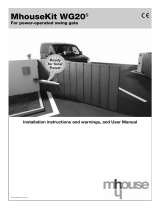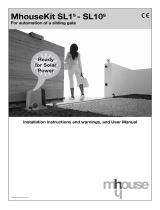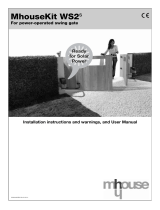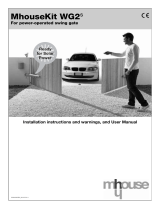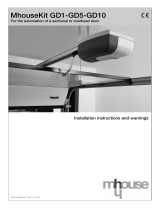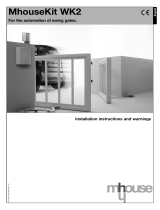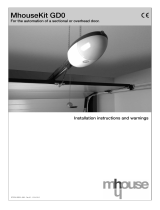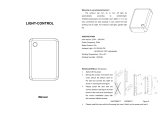Page is loading ...

Installation instructions and warnings
English
IST WS2-GB 4865 Rev. 01 del 11-10-2004
MhouseKit WS2
For the automation of swing gates.

2 Instructions WS2
Information
1 Warnings 3
2 Product description 4
2.1 Applications 4
2.2 Description of the automation 4
2.3 Description of devices 5
2.3.1
Electromechanical Gearmotors with WS1-WS1C curved Arms
5
2.3.2 Release keys 6
2.3.3 Photocells PH1 6
2.3.4 KS1 Key-operated Selector Switch 6
2.3.5 FL1 Flashing Light with Incorporated Aerial 6
2.3.6 TX4 Radio Transmitters 6
3 Installation 7
3.1 Preliminary checks 7
3.1.1 Operating limits 8
3.1.2 Tools and Materials 8
3.1.3 List of cables 8
3.2 Preparing the Electrical System 9
3.2.1 Connection to the Electrical Mains 9
3.3 Installation of the Various Devices 9
3.3.1 WS1 and WS1C gearmotor mounting 9
3.3.2 Photocells 11
3.3.3 KS1 Key-Operated Selector Switch 11
3.3.4 Flashing light FL1 12
3.3.5 Electrical connections to the WS1C control unit 13
3.4 Power Supply Connection 14
3.5 Preliminary checks 14
3.5.1 Recognition of connected devices 15
3.5.2 Recognition of Gate Leaves’ Opening and Closing Angles 15
3.5.3 Checking the Radio Transmitters 15
3.6 Regulations 16
3.6.1 Selecting the Speed of the Leaf 16
3.6.2 Selecting the Type of Operating Cycle 16
3.7 Testing and commissioning 16
3.7.1 Testing 16
3.7.2 Commissioning 17
4 Maintenance 17
4.1 Dismantling and Disposal 17
5 Additional information 18
5.1 Advanced Adjustments 18
5.1.1 Adjusting the Parameters with the Radio Transmitter 18
5.1.2 Checking the Adjustments with the Radio Transmitter 19
5.2 Optional Accessories 19
5.3 Adding or Removing Devices 19
5.3.1 ECSBus 19
5.3.2 STOP Input 19
5.3.3 Recognition of other devices 20
5.3.4 Addition of Optional Photocells 20
5.4 Memorization of Radio Transmitters 21
5.4.1 Mode 1 Memorization 21
5.4.2 Mode 2 Memorization 21
5.4.3 “Remote” Memorization 21
5.4.4 Deleting a Radio Transmitter 22
5.4.5 Deleting all the Radio Transmitters 22
5.5 Troubleshooting 22
5.6 Diagnostics and Signals 23
5.6.1 Photocells 23
5.6.2 Flashing light 23
5.6.3 Control unit 24
6 Technical characteristics 25
7 Annexes 27
7.1 Annexe 1: CE Declaration of Conformity of WS2 Components 29
7.2 Annexe 2: CE Declaration of Conformity of Power Operated Gate 31
7.3 Annexe 3: Operating Guide 33
7.3 Annexes 3: Operating guide 27
7.3.1 Safety regulations 33
7.3.2 Gate Control 33
7.3.3 Maintenance Operations to Be Performed by the User 34
7.3.4 Replacing the Remote Control Battery 34
Contents
This manual may be reproduced provided no part of it is omitted or
modified. No part of this manual may be translated into other languages
without the prior authorisation and subsequent examination by
MHOUSE.
MHOUSE disclaims responsibility for any damage resulting from the
improper use of the products; you are therefore invited to read this
manual carefully.
MHOUSE, in order to improve its products, reserves the right to modify
their technical characteristics at any time without prior notice. In any
case, the manufacturer guarantees their functionality and fitness for the
intended purposes.
For any information please contact:
MHOUSE S.r.l.
via Pezza Alta, 13, ZI 31046 Oderzo
Tel: 0422 202109
Fax: 0422 852582
email: [email protected]
http: www.mhouse.biz

Instructions WS2 3
1 Warnings
• If this is the first time that you install a WS2 gate automation system we
recommend that you dedicate some of your time to reading this man-
ual. You should read it before you start installing the system, so you
don’t have to rush to finish the work.
• Keep all the components of the WS2 system handy so that you can
read, check and verify all the information contained in this manual.
However, do not carry out the adjustment and memorization stages
otherwise, during the actual installation of the products, you will have
to deal with settings that differ from the original factory ones.
•When reading this manual, pay special attention to the sections
marked by the following symbol:
these sections are particularly important for safety.
• Store this manual safely for future use.
• This manual, as well as the design and manufacture of the devices that
make up WS2, comply fully with the standards and regulations in force
• Considering the hazards that may exist during the installation and oper-
ation of WS2, it is necessary that also the installation be carried out in
strict compliance with current legislation, standards and regulations,
particularly:
• This manual contains important information regarding personal
safety; before you start installing the components, it is impor-
tant that you read and understand all the information contained
herein. Do not proceed with the installation if you have doubts
of any sort; if necessary, refer to the MHOUSE customer serv-
ice department for clarifications.
• Before you start with the installation, make sure that each sin-
gle WS2 device is suitable for the intended automation purpos-
es; pay special attention to the data provided in chapter 6
“Technical Characteristics”. If even a single device is not suit-
able for the intended application, do not proceed with the instal-
lation.
• Before you start with the installation, check whether additional
devices or materials are needed to complete the automation
with WS2 based on the specific application requirements.
• The WS2 automation system must not be used until the automa-
tion has been commissioned as described in paragraph 3.7.2
“Commissioning”.
• The WS2 automation system cannot be considered as a suitable
intrusion protection system. If you require efficient protection
you need to integrate WS2 with other devices.
•The packing materials of WS2 must be disposed of in compli-
ance with local regulations.
• Do not make modifications to any components unless provided
for in this manual. This type of operations will only cause mal-
functions. MHOUSE disclaims any liability for damage resulting
from modified products.
• Components must never be immersed in water or other liquids.
During installation, ensure that no liquids leak into the gearmo-
tor and other open devices.
• In the event that liquid substances have penetrated inside the
automation devices, immediately disconnect the power supply
and contact the MHOUSE customer service department. The
use of WS2 in these conditions can be dangerous.
• Keep all components of WS2 away from heat sources and open
flames; these could damage the components and cause mal-
functions, fire or dangerous situations.
• During long periods of inactivity, the optional battery (PR1)
should be removed and stored in a dry location to prevent leak-
age of noxious substances.
•Connect the gearmotor only to a power supply line equipped
with safety grounding system.
•All operations requiring the opening of the protection shell of
any WS2 device must be performed with the control unit dis-
connected from the power supply (and from the PR1 buffer bat-
tery, if featured); if the disconnection device is not identifiable,
post the following sign on it: “WARNING: MAINTENANCE WORK
IN PROGRESS”.
• In the event that any automatic switches are tripped or fuses
blown, you must identify the fault and eliminate it before reset-
ting the switches or replacing fuses.
•If a fault occurs that cannot be solved using the information
provided in this manual, refer to the MHOUSE customer service
department.

A
D G D
E F
B B C
4 Instructions WS2
The following example of a typical WS2 application will serve to clarify a few terms and aspects of a gate automation system:
A) FL1 flashing light with integrated aerial
B) Pair of PH1 photocells.
C) KS1 key-operated selector switch
D) Pair of posts for PT50 photocells (not included)
E) WS1C Gearmotor equipped with integrated command unit
F) WS1 Gearmotor
G) Closing stop (not included)
2.2 Description of the automation
Figure 1
2 Product description
2.1 Applications
WS2 is a set of components designed for the automation of single-leaf
or double-leaf gates in residential applications.
Any applications other than those described above or under
different conditions from those specified in this manual are
forbidden.
WS2 operates with electric power. In the event of a power failure, the
gearmotor can be released using suitable keys in order to move the gate
manually. Alternatively, the PR1 buffer battery (optional accessory) can
be used.

Instructions WS2 5
WS2 consists of the devices shown in figure 2;
make immediately sure that they correspond to
the contents of the package and verify the inte-
grity of the devices.
Note: to adapt WS2 to local regulations, the
contents of the package may vary; an exact list
of the contents is shown on the outside of the
package under the “Mhousekit WS2 contains”
heading.
A) 1 WS1C Gearmotor with incorporated con-
trol unit
B) 1 WS1 Gearmotor
C) 2 Gearmotor mounting plates
D) 3 Release keys.
E) 1 Pair of PH1 photocells (consisting of a TX
and an RX).
F) 2 Covers.
G) 2 TX4 radio transmitters.
H) 1 KS2 key-operated selector switch and two
keys
I) Mounting brackets and anti-shear curved
arms (*)
J) 2 Mechanical stops.
K) 1 FL1 flashing light with incorporated aerial.
L) Miscellaneous small parts: screws, screw
anchors, etc., see tables 1,2, 3, and 4 (*)
(*) the screws needed to secure the motor
mounting plate and the brackets of the arms
to the gate are not supplied because their
type depends on the material and thickness
of the gate.
2.3 Description of devices
WS1C and WS1 are electromechanical gearmotor consisting of a helical
teeth reduction gear and a 24V direct current motor. It features a key-
operated mechanical release mechanism that allows you to move the
gate manually in the event of a power failure. The gearmotors can be
mounted at the side of the gate using the special mounting brackets. The
curved arm and the related mounting bracket enable the connection
between the gearmotor and the gate leaf.
WS1C is complete with a unit that controls the gearmotors and power
supply to the various components; it comprises an electronic card with
incorporated radio receiver.
WS1C is also fitted with a compartment for the PR1 buffer battery (optio-
nal) required for operation in the event of a power failure. The control unit
can activate the gearmotors at two speeds: “slow” or “fast”.
To facilitate the electrical connections there are separate terminals for
each device, which are removable and colour-coded based on the func-
tion performed.Next to each input terminal there is a LED that signals its
status. The connection to the power supply is very easy: just insert the
plug in a power outlet.
WS1 does not have a control unit and must be connected to the relative
terminals of the WS1C control unit.
Table 1: List of small parts for two WS1/WS1C Q.ty
8x30 hex-head screws 2 pcs.
6x80 cylindrical hex countersunk screw 4 pcs.
6x20 cylindrical hex countersunk screw 2 pcs.
8 mm dia. grower washers 2 pcs.
pins 4 pcs.
safety rings 4 pcs.
2.3.1 Electromechanical Gearmotors with WS1-WS1C curved Arms
Figure 3
Figure 2
A
C
D
F
I
L
J
G
E
K
H
B

6 Instructions WS2
2.3.3 Photocells PH1
The pair of PH1 wall-mounted photocells, once they are connected to the
control unit, enable the detection of obstacles found on the optical axis
between the transmitter (TX) and the receiver (RX).
Table 2: List of small parts for PH1 Q.ty
HI LO 4X9,5screw 4 pcs.
3.5X25 self-tapping screw 4 pcs.
s 5 c nylon screw anchor 4 pcs.
2.3.4 KS1 Key-operated Selector Switch
The KS1 key-operated two-position selector switch enables gate control
without using the radio transmitter. It is equipped with internal light for
locating in the dark.
There are two commands, which depend on the direction of rotation of
the key “OPEN” and “STOP”, then the key, which is spring loaded,
returns to the centre position.
Figure 6
2.3.5 FL1 Flashing Light with Incorporated Aerial
The flashing light is controlled by the control unit and signals danger when
the gate is moving. Inside the flashing light there is also the aerial for the
radio receiver.
Figure 7
2.3.6 TX4 Radio Transmitters
The radio transmitters are used for the remote control of the gate open-
ing and closing manoeuvres. They feature four buttons that can all be
used for the 4 types of command to a single automation unit, or to con-
trol up to 4 different automation units.
The transmission of the command is confirmed by the LED [A]; an eyelet
[B] allows them to be hung on a keyring.
Figure 8
B
A
Figure 5
Table 3: List of small parts for KS1 Q.ty
HI LO 4X9,5 screw 2 pcs.
3.5X25 self-tapping screw 4 pcs.
s 5 c nylon screw anchor 4 pcs.
Table 4: List of small parts for FL1 Q.ty
4,2X32 self-tapping screw 4 pcs.
s 6 c nylon screw anchor 4 pcs.
The three keys enable the gearmotor to be released in the event of a
power failure.
2.3.2 Release keys
Figure 4

WS2 must not be used to power a gate that is not efficient and
safe. It cannot solve defects resulting from incorrect installation
or poor maintenance of the gate.
Before proceeding with the installation you must:
• Make sure that the weight and dimensions of the gate fall within
the specified operating limits (see paragraph 3.1.1). If they do
not, WS2 cannot be used.
• Make sure that the structure of the gate is suitable for automa-
tion and in compliance with regulations in force.
• Make sure that there are no points of greater friction in the ope-
ning or closing travel of the gate leaves.
• Check sturdiness of the mechanical stops on closing and ope-
ning (if fitted), and that there is no risk of the deformation even
when the leaf hits the mechanical stop violently.
• Make sure that the gate is well balanced: it must not move by
itself when it is placed in any position.
• Make sure that the area where the gearmotor is fixed is not
subject to flooding. If necessary, mount the gearmotor raised
from the ground.
• Make sure that the location where the gearmotor is installed is
compatible with the overall dimensions of the gearmotor and
that it allows the release manoeuvre to be carried out easily and
safely.
• Make sure that the mounting positions of the various devices
are protected from impacts and that the mounting surfaces are
sufficiently sturdy.
• Make sure that the mounting surfaces of the photocells are flat
and that they enable the proper alignment between TX and RX
•Check the size limits referring to figure 9.
• Check that there is enough space for the arm to rotate
• Using the leaf opening angle as a guideline, check that the
values in Table 5 can be met.
Table 5
1. “B” is a value that can be easily measured on the gate.
2. Use the value of “B” and the leaf opening angle in the table to calcu-
late the value of “A”. E. g.: if “B” equals 100 mm and you require an
opening angle of 100°, “A” should be about 180 mm.
Instructions WS2 7
The installation must be carried out by qualified and skilled per-
sonnel in compliance with the directions provided in this chapter
1 “WARNINGS”.
3 Installation
3.1 Preliminary checks
Figure 9
Figure 10
Figure 11

8 Instructions WS2
3.1.1 Operating limits
3.1.3 List of cables
Figure 13
3.1.2 Tools and Materials
Figure 12
Chapter 6 “Technical Characteristics” provides the fundamental data
needed to determine whether all the WS2 components are suitable for
the intended application.
In general, WS2 is suitable for the automation of gates featuring leaves
up to 1.8 m wide, weighing up to 200 kg, with opening angle of up to
110° for residential applications. The shape of the gate and the climatic
conditions (e.g. presence of strong wind) may reduce these maximum
limits. In this case it is necessary to measure the torque needed to move
the leaves under the worst conditions, and to compare it to the data pro-
vided in the technical characteristics chart for the WS1 and WS1C gear-
motors.
Make sure you have all the tools and materials needed to install
the system; make sure that they are in good condition and serv-
iceable according to current safety standards.
See examples in figure 12.
WARNING: The cables used must be suitable for the type of installation; for example, an H03VV-F type cable is recommended for indoor
applications, while H07RN-F is suitable for outdoor applications.
Note 1 A power supply cable longer than 30 m may be used provided it has a larger gauge, e.g. 3x2.5mm
2
, and that a safety grounding system is
provided near the automation unit.
Note 2 For the ECSbus cables; there are no special contraindications to the use of a single cable that groups together multiple connections; for exam-
ple, the STOP and OPEN inputs can be connected to the KS1 selector switch using a single 4x0,5mm
2
cable.
Table 6: list of cables
Connection Cable type (minimum section values) Maximum length allowed
[A] Power supply line 3x1.5mm
2
cable 30m (note1)
[B] FLASH Light Output 2x0.5mm
2
cable 20m
[C] Radio Aerial RG58 type shielded cable 20m (recommended less than 5m)
[D] ECSBus input/output 2x0.5mm
2
cable 20m (note2)
[E] STOP Input 2x0.5mm
2
cable 20m (note2)
[F] OPEN Input
[G] M1motors output
2x0.5mm
2
cable
3x1 mm
2
cable
20m (note2)
10m
The cables required for the installation of WS2 may vary depending on the type and quantity of devices to be installed; figure 13 shows the cables
needed for a typical installation; no cable is supplied with WS2.
A
D G
B C D D E
F

Instructions WS2 9
3.2 Preparing the Electrical System
3.2.1 Connection to the Electrical Mains
Although the connection of WS1C to the mains power line is not dealt
with in this manual, note that:
• The power supply line must be laid and connected by a qualified
professional electrician
• Alternatively, have a suitably protected 16A “shuko” outlet
installed, where you can plug in WS1C.
• The power supply line must be protected from short circuits and
ground leakage; a device must be provided to enable the
disconnection of the power supply during the installation and
maintenance of WS2 (the plug with outlet are suitable for this
purpose).
With the exception of the power line that supplies the control unit, the
rest of the system uses extra-low voltage (approx. 24V); the wiring can
therefore be done by personnel that is not properly qualified, provided
that all the instructions in this manual are carefully observed.
After selecting the position of the various devices (refer to figure 1) you
can start preparing the conduits for the electrical cables connecting the
devices to the control unit.
The conduits are designed to protect the electrical cables and prevent
accidental breakage, which may be caused by the passage of vehicles,
for instance.
3.3 Installation of the Various Devices
3.3.1 WS1 and WS1C gearmotor mounting
1 Choose the mounting position in accordance with the specifications
in paragraph 3.1 “Preliminary Checks”.
2Check that the mounting surface is perfectly smooth, vertical and suf-
ficiently compact. WS2 does not come with a mounting system, con-
sequently one will have to be chosen according to the surface mate-
rial.
3 As other devices are also connected to the WS1C gearmotor, take
care that one or more lines of suitable dimensions are laid to ensure
correct routing of all cables.
4Using the value of “B” taken from Table 5, place the mounting plate of
the gearmotor on the mounting surface in the required position.
Check that there is a suitable surface at the values in Figure 11, i.e.
where the bracket of the arm is mounted.
5Mark the drilling points using the plate as a template and then drill the
holes in the surface so that 4 anchors can be installed. The anchors
(not supplied) should be at least 8 mm. Secure the plate with screws
[A] and washers [B].
6 Check that the plate is perfectly level.
Otherwise the arm outside the axis will cause a gate malfunction.
7 Set up the gearmotor by fitting the arm [C] with the washer [D], then
fasten the screw tightly [E]. Take care to place the arm towards the
front section.
Figure 14
Figure 15
Figure 16
Figure 17
A
B
NO
Figure 18
E
D
C

10 Instructions WS2
8 Fasten the gearmotor to the plate with the screws [F] and the self-
locking nuts [G].
9 Using the pins supplied [H], and the corresponding safety rings [I], fas-
ten the bent arm to the straight arm, and the leaf mounting bracket to
the bent arm.
10 Swing the leaf to the “gate closed” position.
11 Release the gearmotor using the appropriate release wrench (see the
“Gearmotor Release” paragraph on page 34) and fasten the leaf
mounting bracket to the gate as far away as possible from the post,
extending the arms to their maximum reach (Fig. 11).
12 Secure the bracket using screws suited to the material of which the
gate is constructed.
13 Swing the leaf to the “gate open” required position. Then place the
limit stop up against straight arm [L] and tighten the two screws [M]
fully down.
14 Loosen screw [N] securing the straight arm to the gearmotor and
insert protection cover [O] between the straight arm and washer [P].
Tighten the screw fully down.
15 Release the gearmotor.
16 Remove the upper cover of the gearmotor by pushing with a screw-
driver the closing hook applied in the release ring nut and then pulling
it up.
17 Thread the electrical cable through the conduit and bring it to the con-
trol unit of WS1C then make the electrical connections as follows:
On completion close the cover of gearmotor WS1 inserting it from
above and clicking the front retainer tab into position.
Figure 21
Figure 22
Figure 19
F
G
Figure 20
H
H
I
M
L
N
O
P
Figure 23
blue
yellow/green
brown

Instructions WS2 11
3.3.2 Photocells
1 Select the position of the two photocell elements (TX and RX) accord-
ing to the following instructions:
• Position them at a height of 40-60 cm from the ground, on both sides
of the area to be protected, on the street side of the installation and as
close as possible to the edge of the gate, no further than 15 cm.
• Point transmitter TX towards receiver RX, with a maximum tolerance of
5°.
• In the selected locations there must be a conduit for threading the
cables.
2 Remove the front glass [A] by prising it out with a slotted tip screwdriver
applied to the bottom.
3Press the lens in order to separate the two shells.
4Breach two of the four holes [B] at the bottom with a screwdriver.
5 Position the photocell at the point where the conduit arrives; the hole
at the bottom [D] should match the point where the cables come out
of the wall; mark the drilling points using the bottom as reference
6Drill the holes in the wall using a hammer drill with a 5 mm bit and insert
the 5 mm screw anchors.
7 Secure the bottom with the screw [C].
8 Connect the electric cable to the appropriate TX and RX terminals.
From an electrical viewpoint, TX and RX must be connected in parallel
as shown in figure 28. It is not necessary to observe any polarity. The
terminals can be removed in order to facilitate the operations; make the
connections and then reinsert them.
9 Secure the cover shell [E] using the two screws [F] and a Phillips screw-
driver. Then insert the glass [G], pressing it gently to close it.
Figure 27
Figure 28
Figure 29
Figure 30
B
C
D
C
E
F
G
Figure 26
A
TX
3.3.3 KS1 Key-Operated Selector Switch
RX
1 Determine the position of the selector switch; it must be installed exter-
nally, alongside the gate and at a height of approx. 80 cm, so that it
can be used by people of different height.
2 Remove the front glass [A] by prising it out with a slotted tip screwdriver
applied to the bottom.
3To separate the bottom from the shell you need to insert the key and
keep it turned, then pull with a finger inserted in the hole for the pas-
sage of the cables.
Figure 31
A
Figure 32

1 Select the position of the flashing light so that it is close to the gate in a
visible location; it can be secured to either a vertical or horizontal surface.
2 Slide out the diffuser [A] from the bottom by pressing the two buttons [B]
3 Separate the lamp holder with the aerial from the base.
4Breach the four holes for the screws and the hole for the passage of
the cables in the bottom or side, depending on the installation position,
using a screwdriver.
5 Mark the drilling points using the bottom as reference and make sure
that the hole in the bottom matches the outlet for the cables.
6Drill the holes in the wall using a hammer drill with a 6 mm bit and insert
the 6 mm screw anchors.
7 Secure the bottom with the screws [C].
8 Connect the electrical cables to the appropriate FLASH and “aerial”
terminals as shown in figure 39. You do not need to observe any polar-
ity on the FLASH terminal; however, for the connection of the shielded
cable to the aerial, connect the braid as shown in figure 40. The termi-
nals can be removed in order to facilitate the operations; make the con-
nections and then reinsert them.
9 Insert the lamp holder in the base taking care to press it down until it
locks into place.
10 Slide in the diffuser, pressing the buttons and fitting it on the bottom.
Rotate it in the desired direction then press it down until the two but-
tons snap into their seat.
4Breach the four holes at the bottom with a screwdriver; mark the drilling
points using the bottom as reference; make sure that the hole in the
bottom matches the outlet for the cables.
5Drill the holes in the wall using a hammer drill with a 5 mm bit and insert
the 5 mm screw anchors.
6 Secure the bottom using the four screws [B].
7Connect the electric cables to the appropriate OPEN and STOP termi-
nals, as shown in figure 34. It is not necessary to observe any polarity.
The terminals can be removed in order to facilitate the operations;
make the connections and then reinsert them.
8To insert the shell on the bottom you need to turn the key. After you
have inserted it, turn the key back to the centre position.
9 Secure the body [C] using the two screws [D] and a Phillips screwdriv-
er. Then insert the glass [E], pressing it gently to close it.
Figure 33
3.3.4 Flashing light FL1
Figure 35
B
E
D
C
Figure 36
Figure 37
A
B
Figure 38
C
C
12 Instructions WS2
Figure 34
Figure 39
Figure 40
Figure 41

Instructions WS2 13
1 Remove the top cover of the gearmotor by pushing a screwdriver
under the closing hook inside the release ringnut and pulling the cover
up.
2 Insert the wires for connection of the various devices through the rela-
tive route (at the back left of the gearmotor). Leave cable lengths of at
least 40-50cm.
3Refer to figure 43 for the electrical extra low voltage connection of the
various devices to the control unit terminals.
• The terminals have the same colour coding as the corresponding
devices; for example, the grey terminal (OPEN) of the KS1 selector
must be connected to the grey terminal (OPEN) of the control unit.
• For most connections you do not need to observe any polarity; only
for the shielded cable of the aerial it is necessary to connect the cen-
tral core and the shield as shown in detail [A]. The cable for the sec-
ond WS1 (M1 motor) must be connected as shown in detail [B].
• Keep in mind that, to prevent the jamming of the two leaves, the
WS1C control unit commands the M2 motor (its motor) to open first,
followed by M1 (WS1 one) (vice-versa for the closing manoeuvre).
Therefore make sure that the motor that drives the leaf that strikes
the mechanical stop is connected to terminal M1 (outer one), while
the motor that drives the other leaf must be connected to terminal
M2. Otherwise remove the terminals M1 and M2 and invert them.
• If only one motor is used (single-leaf gate) it must be connected to
terminal M2 while terminal M1 remains free.
3.3.5 Electrical connections to the WS1C control unit
Figure 42
Figure 44
Figure 43
WS1C
M2
WS1
M1
KS1 PH1 PH1
FL1
blue
yellow/green
brown
B
A

4To facilitate the installation operations, the terminals [A] can be removed
as shown in figure 45; make the connections and then re-insert them.
When you have completed the connections, use clamps to secure the
cables to the appropriate slots.
5 Close the gearmotor cover by inserting from above and clicking the
front retainer tab into position.
3.5 Preliminary checks
As soon as WS1C control unit is energised, you should check the fol-
lowing:
1Make sure that the “ECSBus” LED [A] flashes regularly, with about one
flash per second.
2 Make sure that the SAFE LED [B] on the photocells flashes (both on TX and
RX); the type of flashing is not important as it depends on other factors;
what is important is that the LED should not be steadily on or steadily off.
3 Make sure that the night light [C] on the KS1 key-operated selector
switch is on.
4 If the above conditions are not satisfied, you should immediately switch
off the power supply to the control unit and check the cable connec-
tions more carefully. For more useful information see also chapters 5.5
“Troubleshooting” and 5.6 “Diagnostics and Signals”.
Figure 49
Figure 48
B
C
A
Figure 47
14 Instructions WS2
Figure 45
A
3.4 Power Supply Connection
The connection of the WS1C to the mains must be made by a
qualified electrician.
To carry out tests, insert the plug in a power outlet; if necessary, use an
extension cord.
Figure 46

Instructions WS2 15
3.5.1 Recognition of connected devices
When you have completed the initial checks, the control unit must recog-
nise the devices connected to it on the “ECSBus” and “STOP” terminals.
1 On the control unit, press the P2 button [C] and hold it down for at least
three seconds, then release the button.
2Wait a few seconds for the control unit to finish recognising the
devices.
3When the recognising procedure is completed, the STOP LED [A] (the
one over the red terminal), must remain on, while the P2 LED [B] must
go off. If the P2 LED flashes it means that an error has occurred: see
paragraph 5.5 “Troubleshooting”.
The connected devices recognition stage can be repeated again at any
time, even after the installation (for example, if an additional photocell is
installed); just repeat the procedure starting from step 1.
Figure 50
B
A
C
After recognising the devices, the control unit must recognise the leaves’
opening and closing angles.
During this stage, the leaves’ opening angle is measured from the clos-
ing mechanical stop to the opening mechanical stop.
1 Release the motors using the appropriate keys (see the “Gearmotor
Release” paragraph on page 34) and move the leaves to mid travel so
that they are free to move in both opening and closing directions; then
lock the motors.
2 On the control unit, press the P3 button [B] and hold it down for at
least three seconds, then release the button.
Wait for the control unit to complete the recognition stage: closing of the
M1 motor to the mechanical stop, closing of the M2 motor to the
mechanical stop, opening of the M2 and M1 motors to the opening
mechanical stop; complete closing of M1 and M2.
• If the first manoeuvre of one or both leaves is not to close, press P3 to
interrupt the recognition stage, then switch the polarity of the motor/s
that opened by exchanging the two brown and blue wires on the ter-
minal.
• If the first motor to move in the closing direction is not M1, press P3 to
interrupt the recognition stage, then switch the the terminals of the two
motors.
• If any device is triggered during the recognition stage (photocells, key-
operated selector switch, pressure on P3, etc.), the recognition stage
will immediately be interrupted. It will therefore be necessary to start
again from the beginning.
3 If at the conclusion of the search the P3 LED [A] flashes, it means that
an error has occurred; see paragraph 5.5 “Troubleshooting”.
The opening angles recognition stage can be repeated again at any time,
even after the installation (for example, if one of the opening stops is
removed); just repeat the procedure starting from step 1.
3.5.2 Recognition of Gate Leaves’ Opening and Closing Angles
Figure 51
Figure 52
A
B
3.5.3 Checking the Radio Transmitters
To check the transmitters just press one of the four buttons, make sure
that the red LED flashes and that the automation executes the com-
mand.
The command associated to each button depends on how they have
been memorized (see paragraph 5.4 “Memorization of Radio Transmit-
ters”). The transmitters supplied have already been memorized and when
you press the buttons the following commands are transmitted:
T1 button “OPEN” command
T2 button “Pedestrian Gate” command
T3 button “Open only” command
T4 button “Close only” command
T1
T2
T3
T4

1 Make sure that the provisions contained in chapter 1 “WARN-
INGS” have been carefully observed;
2 Using the selector switch or the radio transmitter, test the opening
and closing of the gate and make sure that the gate moves in the
intended direction.
The test should be carried out a number of times to make sure that
the gate moves smoothly, that there are no points of excessive friction
and that there are no defects in the assembly or adjustments.
3 Check the proper operation of all the safety devices, one by one (pho-
tocells, sensitive edges, etc.). In particular, each time a device is acti-
vated the “ECSBus” LED on the control unit flashes for a longer time,
confirming that the control unit recognises the event.
4To check the photocells and make sure that there is no interference
with other devices, pass a 5 cm diameter, 30 cm long cylinder on the
optical axis, first near TX, then near RX and finally at the mid-point
between them and make sure that in all these cases the device is trig-
gered, switching from the active to the alarm status and vice-versa;
finally, that it causes the intended action in the control unit, for exam-
ple that it causes the reversal of the movement during the closing
manoeuvre.
5 Measure the impact force according to EN standard 12445. If “motor
force” control is used to assist the system for the reduction of the
impact force, try to find the adjustment that gives the best results.
3.6.2 Selecting the Type of Operating Cycle
The opening and closing of the gate can take place according to differ-
ent operating cycles:
•Single cycle (semiautomatic): the gate opens with a command and
stays open until the next command is given, causing it to close.
• Complete cycle (automatic closing): the gate opens with a command
and then closes automatically after a short time (for the time, see para-
graph 5.1.1 “Adjusting the Parameters with the Radio Transmitter”).
To switch from one operating cycle to the other press the P3 button [B]
momentarily; the corresponding LED [A] will light up or go off; if the LED
is off the cycle is “single”, if the LED is on the speed is “complete”.
3.7 Testing and commissioning
These are the most important operations in the automation designed to
guarantee the maximum safety and reliability of the automation system.
Testing can also be adopted as a method of periodically checking that all
the various devices in the system are functioning correctly.
Testing of the entire system must be performed by qualified and
experienced personnel who must establish which tests to con-
duct on the basis of the risks involved, and verify the compliance
of the system with applicable regulations, legislation and stan-
dards, in particular with all the provisions of EN standard 12445
which establishes the test methods for automation systems for
gates.
3.7.1 Testing
Figure 55
16 Instructions WS2
3.6 Regulations
3.6.1 Selecting the Speed of the Leaf
The leaves can be opened and closed at two speeds: “slow” or “fast”.
To switch from one speed to the other press the P2 button [B] momen-
tarily; the corresponding P2 LED [A] will light up or go off; if the LED is off
the speed is “slow”, if the LED is on the speed is “fast”.
Figure 53
A
B
Figure 54
A
B

Instructions WS2 17
3.7.2 Commissioning
Commissioning can take place only after all the testing phases
have been terminated successfully. Partial commissioning or
implementation of “temporary” conditions are not permitted.
1Prepare and store for at least 10 years the technical documentation
for the automation, which must include at least: assembly drawing
(e.g. figure 1), wiring diagram (e.g. figure 13), analysis of hazards and
solutions adopted, manufacturer’s declaration of conformity of all the
devices installed. For WS2 use Annexe 1 “EC Declaration of Confor-
mity of the WS2 components”.
2 Post a label on the gate providing at least the following data: type of
automation, name and address of manufacturer (person responsible
for the “commissioning”), serial number, year of manufacture and “CE”
marking.
3 Fill out the declaration of conformity and deliver it to the owner of the
automation system; for this purpose you can use Annexe 2 “EC Dec-
laration of Conformity”
4Prepare the operating guide and deliver it to the owner of the automa-
tion system; Annexe 3 “OPERATING GUIDE” can be used as an
example.
5Prepare the maintenance schedule and deliver it to the owner of the
automation system; it must provide directions regarding the mainte-
nance of all the automation devices.
6 Before commissioning the automation system inform the owner
regarding dangers and hazards that are still existing.
The maintenance operations must be performed in strict compli-
ance with the safety directions provided in this manual and
according to the applicable legislation and standards.
The devices used for the WS2 automation system do not require any
special maintenance. However, periodically make sure (at least once
every six months) that all the devices are perfectly efficient.
To this end, carry out all the tests and checks described in paragraph
3.7.1 “Testing” and the operations described in paragraph 7.3.3 “Main-
tenance Operations to Be Performed by the User”.
If other devices are present, follow the directions provided in the corre-
sponding maintenance schedule.
4 Maintenance
4.1 Dismantling and Disposal
WS2 is constructed of various types of materials, some of which can be
recycled: steel, aluminium, plastic, electric cables; while others must be
disposed of (boards and electronic components).
WARNING: some electronic components may contain polluting
substances; do not pollute the environment. Enquire about the
recycling or disposal systems available in compliance regulations
locally in force.
1 Contact a qualified electrician regarding the disconnection of the
automation system from the electric mains.
2Disassemble all the devices and accessories, following in reverse
order the procedures described in chapter 3 “Installation”.
3Remove the batteries from the radio transmitters.
4 Remove the electronic boards.
5 Sort the various electrical and recyclable materials and consign them
to licensed firms for recovery and disposal.
6 Consign the remaining materials to authorised scrap collection cen-
tres.

18 Instructions WS2
The radio transmitter can be used to adjust certain control unit operation
parameters: there are four parameters and each of them can have four
different values:
1) Pause Time: time during which the leaves remain open (in the auto-
matic closing mode).
2) Pedestrian gate: pedestrian gate opening mode.
3) Motor force: maximum force beyond which the control unit recognis-
es an obstacle and reverses the movement.
4) “OPEN” function: sequence of movements associated to each
“OPEN” command.
The following chapters describe different ways of customising WS2 to
make it suitable for specific application requirements.
5 Additional information
5.1 Advanced Adjustments
5.1.1 Adjusting the Parameters with the Radio Transmitter
Table 8:
Parameter No. value Action: operation to be performed at point 3 in the adjustment phase
Pause Time
1° 10s Press button T1 once
2° 20s (*) Press button T1 twice
3° 40s Press button T1 three times
4° 80s Press button T1 four times
Pedestrian gate
1° 1 leaf half way Press button T2 once
2° 1 leaf all the way (*) Press button T2 twice
3° Partial 2 leaf opening to 1/4 of stroke Press button T2 three times
4° Partial 2 leaf opening to 1/2 of stroke Press button T2 four times
Motor force:
1° Low Press button T3 once
2° Medium-low (*) Press button T3 twice
3° Medium-high Press button T3 three times
4° High Press button T3 four times
“OPEN” function:
1° “Open”-“Stop”-“Close”-“Stop” Press button T4 once
2° “Open”-“Stop”-“Close”-“Open” (*) Press button T4 twice
3° “Open”-“Close”-“Open”-“Close” Press button T4 three times
4° Only opening Press button T4 four times
(*) Original factory setting
The parameter adjustment operation can be performed using any of the
radio transmitters, provided they are memorized in mode 1 like the ones
supplied (see paragraph 5.4.1 “Mode 1 memorization”).
If no transmitter memorized in Mode 1 is available, you can memorize
one just for this phase and delete it immediately afterwards (see para-
graph 5.4.4 “Deleting a radio transmitter”).
WARNING: when using the transmitter to make adjustments you need
to give the control unit time to recognize the radio command; this means
that the buttons must be pressed and released slowly, held down for at
least one second, then released for one second and so on.
1Press buttons T1 and T2 on the radio transmitter simultaneously for
at least 5 s.
2 Release the two button.
3Within 3 seconds, perform the action described in Table 8 based on
the parameter to be modified.
Example: to set the pause time at 40 s.
1° Press buttons T1 and T2 and hold them down for at least 5 s
2° Release T1 and T2
3° Press button T1 three times
All the parameters can be adjusted as required without any contraindi-
cation; only the adjustment of the “motor force” requires special care:
• Do not use high force values to compensate for points of abnormal fric-
tion on the door. Excessive force can compromise the operation of the
safety system or damage the leaf.
• If the “motor force” control is used to assist the impact force reduction
system, measure the force again after each adjustment in compliance
with EN standard 12445.
•The weather conditions may affect the movement of the leaf, therefore
periodic re-adjustments may be necessary.
Figure 56

Instructions WS2 19
With a radio transmitter memorized in Mode 1, you can check the values
set for each parameter at any time by following the sequence described
below:
1Press buttons T1 and T2 on the radio transmitter simultaneously for
at least 5 s.
2 Release the two buttons.
3Within 3 seconds, perform the action described in Table 9 based on
the parameter to be checked.
4 Release the button when the flashing light starts flashing.
5 Count the flashes and, based on their number, check the correspon-
ding value in table 8.
Example. If the flashing light flashes three times after you have pressed
T1 and T2 for 5 s and then button T1, the pause time is set at 40 s.
5.1.2 Checking the Adjustments with the Radio Transmitter
Table 9:
Parameter Action
Pause Time Press button T1 and hold it down
Pedestrian gate Press button T2 and hold it down
Motor force: Press button T3 and hold it down
“OPEN” function: Press button T4 and hold it down
5.2 Optional Accessories
In addition to the devices featured in WS2, other ones are available as
optional accessories designed to enhance the automation system.
PR1: 24V buffer battery for supply in the event of power failure. It guar-
antees at least 10 complete cycles. When the system is powered by the
battery, the manoeuvre takes place only in “slow” speed mode.
PT50: Pair of 500 mm posts with one photocell
PT100: Pair of 1000 mm posts with two photocells
For information on the new accessories, refer to the MHOUSE catalogue
or visit the site www.mhouse.biz.
5.3 Adding or Removing Devices
Devices can be added to or removed from the WS2 automation system
at any time.
Do not add any devices until you have made sure that they are
perfectly compatible with WS2; for further information contact
MHOUSE Customer Service.
5.3.1 ECSBus
ECSBus is a system that allows you to connect the ECSBus devices
using only two wires which carry both the power supply and the com-
munication signals. All the devices are connected in parallel on the 2
wires of the ECSBus itself; each device is individually recognised
because a univocal address is assigned to it during the installation.
The photocells, as well as other devices that adopt this system, can be
connected to ECSBus, such as safety devices, control buttons, signalling
lights etc. For information on the ECSBus devices, refer to the MHOUSE
catalogue or visit the site www.mhouse.biz.
The control unit recognises all the connected devices individually through
a suitable recognition process, and can detect all the possible abnor-
malities with absolute precision. For this reason, each time a device con-
nected to ECSBus is added or removed, the control unit must go
through the recognition process; see paragraph 5.3.3 “Recognition of
Other Devices”.
5.3.2 STOP Input
STOP is the input that causes the immediate interruption of the manoeu-
vre (with a short reverse run). Devices with output featuring normally
open “NO” contacts (like the KS1 selector switch) and devices with nor-
mally closed “NC” contacts, as well as devices with 8.2KΩ constant
resistance output, like sensitive edges, can be connected to this input.
Multiple devices, even of different type, can be connected to the STOP
input if suitable arrangements are made.
To do this, proceed as described in the following table:
Note 1. The NO and NC combination can be obtained by placing the two con-
tacts in parallel, and placing in series to the NC contact an 8.2KΩ resistance
(therefore, the combination of 3 devices is also possible: NO, NC and 8.2kΩ).
Note 2. Any number of NO devices can be connected to each other in
parallel.
Note 3. Any number of NC devices can be connected to each other in
series.
Note 4. Only two devices with 8.2KΩ constant resistance output can be
connected in parallel; if needed, multiple devices must be connected “in
cascade” with a single 8.2KΩ termination resistance.
Warning: if the STOP input is used to connect devices with safe-
ty functions, only the devices with 8.2KΩ constant resistance
output guarantee the fail-safe category 3.
During the recognition stage the control unit, like ECSBus, recognises
the type of device connected to the STOP input subsequently it com-
mands a STOP whenever a change occurs in the recognised status.
Table 10
1
ST
device type
NO NC
8,2kΩ
2nd device type
NO
In parallel
(note 2)
(note 1) In parallel
NC
(note 1)
In series
(note 3)
In series
8,2kΩ
In parallel In series
In parallel
(note 4)

20 Instructions WS2
Normally the recognition of the devices connected to the ECSBus and
the STOP input takes place during the installation stage. However, if new
devices are added or old ones removed, the recognition process can be
gone through again by proceeding as follows:
1 On the control unit, press the P2 button [B] and hold it down for at
least three seconds, then release the button.
2Wait a few seconds for the control unit to finish recognising the
devices.
3When the recognition stage is completed the P2 LED [A] should go
off. If the P2 LED flashes, it means that an error has occurred; see
paragraph 5.5 “Troubleshooting”.
4 After you have added or removed any devices, the automation sys-
tem must be tested again according to the directions contained in
paragraph 3.7.1 “Testing”.
5.3.3 Recognition of other devices
Figure 57
5.3.4 Addition of Optional Photocells
Additional photocells can be installed at any time on top of those supplied
with WS2. In an automation system for 2-leaf gates these can be
arranged as shown in figure 58.
Figure 58
Table 11
Photocell h=50; activated
when gate closes
A
Photocell h=100; activated
when gate closes
B
C
Photocell h=50; activated
when gate opens or closes
Photocell h=100; activated
when gate opens or closes
D
Photocell to the right;
activated when gate opens
Photocell to the left;
activated when gate opens
F
Photocell
Jumpers
Jumpers
Photocell
E
To ensure the correct recognition of the photocells by the control unit, the for-
mer must be assigned addresses by means of jumpers. The address alloca-
tion procedure must be performed on TX as well as RX (arranging the jumpers
in the same manner), but you must make sure that there are no other pairs of
photocells having the same address.
Photocell address allocation is used to enable the correct recognition
between other devices of the ECSBus and to assign the specific function.
1 Open the shell of the photocell.
2 Identify the position where they are installed based on figure 57 and
connect with jumper according to Table 11.
The unused jumpers must be stored in their proper compartment for
future use (Figure 59).
3 Perform the recognition stage as explained in paragraph 5.3.3
“Recognition of other devices”.
Figure 59
A
B
/
